Like some cat from Japan
A tribute to david bowie.
From The Japan Times
Photos by Masayoshi Sukita and Yoshiaki Miura
The late David Bowie's appreciation of Japan and its culture was strong. Following his recent death, The Japan Times asked five people who share that connection with the country, and who witnessed the decades-spanning trajectory of this starman, to recall what his sound and vision meant to them.

Bowie’s portable Japan
By Nick Currie Special to The Japan Times
I first learned that David Bowie had died while riding the Beetle jetfoil ferry from South Korea to Japan. Among the myriad thoughts that flooded through my mind during the crossing — for Bowie has been my lodestar, an absolutely determinant influence in my life as the musician Momus — was the bittersweet idea that I was returning to a land that provided a large part of Bowie’s inspiration.
Visions of “Bowie’s Japan” rose in memory as the Kyushu coastline loomed closer. I pictured images taken by photographer Masayoshi Sukita, of course, including the glazed Expressionist-inspired pose on the cover of “Heroes,” later revived for his penultimate album “The Next Day.” I then recalled the costumes of Kansai Yamamoto, in particular an outfit depicting moon-dwelling woodland creatures first unveiled at a 1972 “Ziggy Stardust” show. And I remembered Bowie sipping milk during a 1978 interview for TV show “Star Sen Ichiya” while he explained that kabuki theater had taught him “the discipline of movement.”
I thought of the places in Kyoto — Bowie’s favorite city in Japan — he loved to return to: Tawaraya Ryokan, where he stayed with Iman on their honeymoon, and the now-vanished Cafe David on Sanjo-dori, just opposite the Museum of Kyoto. The “David” in that case was U.S. Sinologist David Kidd (who also died of cancer at the age of 69, back in 1996). Kidd had a house in Kyoto called Togendo, as well as a school dedicated to teaching traditional Japanese arts. Bowie stayed at Togendo in 1979 for some weeks, and even hinted to Western press that the city might become his permanent home.
“I’m not quite sure where to go next,” he told radio interviewer Andy Peebles in 1980. “The East beckons me — Japan — but I’m a bit worried that I’ll get too Zen there and my writing will dry up.”
Sukita took the opportunity of Bowie’s stay in Kyoto to photograph him on the subway — images in which Bowie looks both otherworldly and strangely at home (his fellow Japanese passengers share his lean look and high cheekbones). The photographer also made a series of studio shots in which Bowie, dressed as a salaryman in a belted Burberry coat and makeup redolent of early Yellow Magic Orchestra, stands between the numerals of a huge white clock face, an attache case and newspaper tucked under his arm. The shots didn’t see the light of day until Sukita published “Speed of Life ” in 2012, a limited edition book of his Bowie portraits.
In the end, Bowie decamped to New York, which became the closest thing to a permanent home this nomadic soul would have. But whenever I re-enter Japan, I think of myself as somehow inhabiting one of the singer’s discarded skins, living out for him one of the lives he sketched for himself and — ever impatient for the next thing — moved on from. Based on my experience, I would guess that living in Japan wouldn’t have made Bowie’s writing dry up at all — quite the contrary. Japan seems to turn expat artists usefully in on themselves, making their earliest and deepest influences clearer to them and threshing inconsequential chaff from the cultural wheat. As Donald Richie noted in his journal one year into the nearly 70 he would spend in Japan, “Another country, I am discovering, is another self.”
However, Bowie was never short of other selves to explore, and seems to have carried his own personal Japan with him wherever he went. Returning here without him is heartbreaking but it’s also, in a sense, returning to him — to some of this amazing artist’s deepest creative roots.
Nick Currie is a Scottish-born writer and musician who records under the name Momus and currently lives in Kyoto.

The Voice that stayed with me
By Morgan Fisher Special to The Japan Times
It’s That Voice. I suddenly realized it today when I saw a YouTube montage of clips from his concerts. No matter the song, the style, the era, David Bowie’s voice rings out clear and soars over the music, from a rich fruity baritone to heart-rending falsetto bends, grabbing me like no other singer has.
Of course it’s everything else, too: a complete, unassailable product. The unique songs, startling melodies, enigmatic lyrics, innovative arrangements and soundscapes, the bizarre yet alluring makeup and clothes, the ever-changing personality and controversial behavior — the whole package was extraordinary. Written off by some as a cracked actor, a hollow man, there were also thousands like me who were drawn to this man who in front of us all was openly seeking, experimenting, searching in a way that no spiritual seekers, avant-garde experimenters, or philosophical searchers have done. He did it large, within the public arena, the music biz, the pop scene.
In 1966, age 16, I first saw him play in the tatty old Marquee Club in London’s Soho. He played there 15 times that year, billed as David Bowie and the Buzz. I saw him at least three of those times, and after the initial impact, I made sure I’d get there earlier next time so as to be nearer the front and get a closer look at this charismatic being with piled-up blond hair and impossibly wide belts. I’d rush straight from school, still in uniform, this timid little lad who hadn’t even become a mod yet (that happened a year later). The Marquee didn’t have a drink license yet (only Coca-Cola was served), so I didn’t need to lie about my age to get in.
Fifty years on, it is the sound of his voice that stays with me even now, echoing through a cheap PA system, and yet it thrilled me. The song from that era that lingers the most is “The London Boys” — a surprisingly mature, compassionate ode written by 19-year-old Bowie, about young lads who moved up to London and got into the pill-taking scene, bought flash clothes and realized how hollow it all was. I didn’t understand the lyrics much then, but the repeating refrain — “The London boys, the London boys” — gave me goose pimples and echoed in my mind on the Tube ride back home. Melodrama or magic? It felt like the latter to me.
Three years on, in 1969, by now a fairly successful musician, I was drinking one night in The Speakeasy — a secluded London hideaway for rockers where, over the years, I bumped into icons from Hendrix to Tiny Tim to Sid Vicious. On my way out in the small hours, having imbibed, as usual, several Scotch-and-Cokes, a record company exec I knew thrust a 7-inch promo record into my hand, saying, “Here — you might like this. It’s a new single by an interesting singer-songwriter.”
“Ah, OK, whatever,” I replied.
The next day, after a bleary breakfast, I played the single, not expecting much, and was immediately transported into a shimmering other world. I hadn’t even looked at the label, but there was That Voice again. It was Bowie.
The song was “Space Oddity,” released just a year after Kubrick’s epic “2001: A Space Odyssey.” The opening words “Ground control to Major Tom” in that edgy baritone voice gave me the familiar shivers, and I tried not to spill my tea on the sofa. Then the arrangement — still one of his best — held me open-mouthed for the entire five minutes of the song (very long for a single). I played it again and again, awed by the evolving blend of guitars, vibes, Stylophone and Mellotron. There was no YouTube in those days, and precious little exposure on TV. It was the sound of an artist that grabbed us music lovers 99 percent of the time. And grab me this did.
Jump forward four years and I am out of work and about to experience a major change in my life, directly due to Mr. Bowie. Famously, he rescued a band called Mott the Hoople from splitting up, by giving them one of the best songs he ever wrote — “All The Young Dudes.” It gave them their first hit (No. 3 in the U.K.) and steered them in a new direction, away from the Dylan/Stones blend of rock they had been wowing audiences nationwide with (but without the accompanying boom in record sales — hence their decision to split). Bowie then produced their album of the same name. Their keyboard player didn’t much like the new direction they were going in and left the band.
Through an audition, I got the job in the summer of 1973. A whirlwind of U.S./Europe tours and recordings followed, culminating on Dec. 14 in a sold-out show at what was then Hammersmith Odeon, with a new young band called Queen as opening act. Throughout the afternoon rehearsals, the gossip was going around backstage that not only Bowie but Mick Jagger (with whom it was rumored he had been having an affair) would attend. It was on, it was off, they would be coming, they won’t make it — all through the afternoon conflicting calls were received, doubtless from some hapless secretary egged on by the giggling duo. Finally, just before showtime, they strode smiling into our seedy old dressing room. I handed them paper cups of cheapo wine — this is what gigging musicians are used to anywhere. They went into a huddle with our singer Ian Hunter, teasing him as he got dressed, saying, “Ooh, getting ready for our audience, are we ...?”
Once we started the show I, seated stage right behind my grand piano, sensed some movement behind me. It was the dynamic duo, arm-in-arm in the wings, dancing to our music with daft grins on their faces. They kept it up for the whole show, keeping me on my toes, playing the best I could for these two leaping legends just a couple of yards behind me. Then they slipped away sneakily before the encore, and that was the last time I saw David Bowie.
I kept in close touch with his music throughout the ’70s, buying every album, always moved and impressed by the multifarious ways he could sing. “Station to Station” was an LP I played constantly during one U.S. tour, on my portable record player. The long opening sound of a steam train leading a full three minutes later into the shiveringly haunting words, “The Ret-u-u-u-rn of the Thin White Duke, throwing darts in lovers’ eyes” had me enthralled every time. There is no question in my mind that without That Voice, Bowie’s career would have come to naught. It is the essence and soul of a deeply passionate, deeply creative artist.
That Voice still emotes and exhilarates as richly in his swansong (the “Blackstar” album) as it did that evening when a shy young schoolboy, on his own, watched an almost equally young singer in a tatty rock club all those years ago. RIP, you Singer.
Morgan Fisher , formerly of Mott the Hoople, has been making music and art in Tokyo since 1985.

Fifteen minutes more
By Mark Thompson Staff writer
One day in 1996, when I was working as an editor/writer on the features desk, I arrived at work and was told as I walked in the door that an unnamed person had called. They were looking for someone at The Japan Times to do a one-on-one interview with David Bowie.
I thought I was being pranked. I had to ask the person who took the call several times to confirm its veracity. One on one. David. Bowie. The Bowie. Three hours from now . Got it.
I briefly tried to rationalize backing out. Earlier that morning, I thought I was coming down with a fever, but for some reason, I decided to come into work anyway. What if the Man catches my cold and has to cancel his tour, disappointing his legion fans in Japan? I would be the cause of immeasurable pain.
Truth to be told, I was starting to lose faith in the latter-day Bowie. Critics were hailing his reunion with Brian Eno, but I really hadn’t listened much to his 20th studio release, “Outside.”
I was, however, interested in news of the tour: Nine Inch Nails opened the U.S. leg, he was experimenting with fresh sonic textures, and best of all, the new and improved Bowie was performing reworkings of past gems. That sounded like a good excuse to question him about songs of his heyday. I also was keen to talk to him about how he felt playing Andy Warhol in the soon-to-be-released “Basquiat.” And this was ... you know, that guy.
I had previously had a not-so-close encounter with him in 1983. My college roommate and I had journeyed to a Washington, D.C., suburb to witness my thin but slightly tan hero play to thousands. Lacking the best seats in the cavernous house, we contented ourselves to the sounds of serious moonlight and the awe-inspiring vision of his face, singing on the three-story-tall stage-side monitors.
Thirteen years later, I found myself in a Hotel Okura suite, 3 feet away from that face. The curtains were drawn and only one light lit the corner. It was probably the last interview of the day. I was given only 15 minutes.
I was an amateurish mess. By birth, I suck at time management, but I partly blame him — for being genuinely talkative, incredibly generous and remarkably human. If only he had been curt and arrogant.
We talked about the shiny new toys on the World Wide Web (he liked its potential but concluded that it seemed to be for the “dumping of inconsequential crap”); the irony of him portraying Warhol on the silver screen; and how it was to play with Trent Reznor (he said something, as diplomatically as possible, about him being raw and unsophisticated).
In hindsight, I am embarrassed by my hubris. Who was I to challenge him about my perception of a rivalry between him and Warhol? Who said I could ask him virtually anything?
His minder, who could have easily been his mother, came in at the 15-minute mark and politely said time was up. I silently panicked, realizing I hadn’t really done my job properly. I had forgotten the prime reason I was here with him in this dimly lit room. Conversely, maybe Bowie was wondering if this fanboy would ever get around to asking him about his latest album, the tour, his love of Japan. Or maybe I was just amusing.
He asked if we couldn’t extend it for another 15. She tilted her head, as if she was about to say, you’ve smoked too many cigarettes today, talked too much, and you have a show tomorrow. But she said yes, and I was back in the game.
When the interview finally finished, and I had gathered my things to leave, he asked if I could come along to the show later, as if he was just playing a few ditties down the street in a little pub — and not the Budokan. I didn’t tell him that my pilgrimage from the South to the capital — in an aging VW bug in August, with no AC — took 24 hours and that we constantly fought over control of the tape player. I didn’t tell him that I had memorized the lyrics of most of his pre-1984 catalog. I didn’t even ask him for his autograph. I just said yes, I’d catch the show, thanked him for extending the chat, shook his hand and tried not to faint.
I know what I’ll be singing next time we go to karaoke. Forgive me if I get choked up, but it will happen.
Mark Thompson is the deputy managing editor of The Japan Times. Proof of his encounter can be found here .

The man who sold the world on music
By Giovanni Fazio Special to The Japan Times
The Starman has departed for his home planet. I can’t imagine a world without David Bowie, but the strange thing is, he never was in my world, at least physically. So why do I feel the loss as dearly as I would my closest friend?
Maybe because even though I never met Bowie, his voice, his thoughts, his style, his different colored eyes, his music has permeated my life and become part of it, a marker as clear as any anniversary or season or journey.
It’s not celebrity worship, although there’s no denying his aloof sensuality, a male Garbo for the Moonage generation. Bowie was our white rabbit, racing headfirst down that hole into Wonderland and daring us all to keep up. If you grew up in the ’70s or ’80s, and you felt a bit different, a bit too skinny or queer or daydreamy or strange, Bowie was the one to tell you to go for it, to be more that thing that sets you apart, to embrace it, for in that acceptance is power.
I can put on “Heroes” and my freshman year of college unfurls before my eyes: my first girlfriend and I swallowing a little piece of paper made by bearded wizard M.I.T. undergrads and dissolving into an undulating spring dusk as we saw the world like we’d just been born. Side two of “Heroes” — electric, still, and shimmering — was the first clue on a trail that led to Brian Eno, Robert Fripp, ambient music, the Berlin School, and a whole realm of innovative electronic music that would inspire my own career as a musician. “Moss Garden,” in particular, insinuated an interest in koto music and Zen, which would soon lead (along with other influences) to a year abroad in Kyoto, where I knew Bowie had a home as well.
Years later I learned that on “Heroes” Bowie had used Oblique Strategies, a deck of cards with mysterious bits of advice that Eno had invented where you would draw one at random to throw a little chaos into the creative process; I would go on to use them on my own albums — with one piece, “Ghost Echoes,” entirely inspired by a card — but more importantly, this technique taught me how to make good use of chance, and to recognize it when it came.
All this just from “Heroes.” Bowie’s albums teemed with ideas and possibilities; they were gateways. As the years go by, as pop music races by in a blur of Marilyn Mansons and Lady Gagas, and as gender-bending becomes the cause celebre, his influence looms ever larger.
Bowie was ubiquitous when I first came to Japan in 1983, as Nagisa Oshima’s “Merry Christmas, Mr. Lawrence” had just opened to great acclaim. Later the band Boowy would take his name and inspire an entire genre, visual-kei (though goth and cosplay surely owe as much to Ziggy and the Starman). Working as this paper’s critic, many of the films that got deepest under my skin were those by David Lynch, and Bowie was there too, appearing in “Twin Peaks” and contributing to the soundtrack for “Lost Highway.” Anyone of a certain age will never forget the use of “Modern Love” in Leo Carax’s “Boy Meets Girl”: Pure euphoria on film. Dare I mention “Labyrinth,” that silliest of secret ’80s pleasures?
These days, my girlfriend and I are in a habit of throwing on “Hunky Dory” for morning coffee. Might have been that “wake up your sleepyhead” line, but for several years now, we still listen to it more often than not, and Bowie’s been with us to Angkor Wat and Sedona’s Red Rocks. If a day starts with Bowie, it’s usually gonna be a good day. It also reminds me, in this age of fragmented attention spans, the pleasures to be found in a committed relationship with an album. Everyone knows “Changes” and “Life on Mars,” but listen long enough and “Quicksand” and “Andy Warhol” become just as good.
These are just my memories, but they’re memories intertwined with and shaped by Bowie, and you have yours, then multiply that by millions around the world. The magic of music is this ability to insinuate itself into the fabric of our lives, to become one with our deepest, closest memories. I hope that whatever corner of the universe the Starman now finds himself in, that he can look down and see this matrix that he has transmitted. Right now, all across this blue, blue, electric blue planet, people are playing “Heroes,” “Jean Genie,” “Cat People,” “Subterraneans” and more.
Look out your window, I can see his light; if we sparkle, he may land tonight.
Giovanni Fazio is a film critic for The Japan Times and also has a 20-year recording career as the artist Makyo.

Ground Control to Major Jack
By Roger Pulvers Special to The Japan Times
I first met David Bowie in August 1982 in Auckland, New Zealand, where the crew of Nagisa Oshima’s “Merry Christmas, Mr. Lawrence” had come together for the flight to the film’s location in Rarotonga, Cook Islands. From the outset he came across as a man of great personal warmth, devoid of any pretence. And this proved to be the case throughout the shoot, which lasted from late in that month until the end of September, when we returned to Auckland to film the flashback scenes in the life of his character, Maj. Jack Celliers.
I was with him every day, on the set and off, drinking with him in the seaside hotel bar, at the little island’s Chinese restaurant (the Jade Garden, no longer there), and in scene after scene in the jungle’s clearing. I stood in for him in a sandpit in the dead of night. In fact, I should say “sat in,” because there was a chair in that pit. Boards with sand on them covered the area around my head. I spent about 40 minutes in that pit, trying to blow away huge moths attracted to the bright lights. Bowie was rushed over from his room. He entered the pit and five minutes later the shot was taken. He threw me a sympathetic smile as he was whisked away.
“I feel terrific on this island,” he said to me as we strolled to the old courthouse in the town of Avarua. We were going to a wedding … a real wedding. Producer Jeremy Thomas and his fiancee had decided to marry on the island.
“This is the only place I have ever been where I am not recognized,” Bowie said.
He was totally at ease on Rarotonga, not even bothering to use his real name. In Auckland, he registered at the hotel under his real name, David Jones. There was no media presence on the island. (As author of the film’s press releases, I was the only “media” there.) When we were in Auckland, he was much more protected and considerably more wary of strangers.
He was soft-spoken. He smiled when he spoke, and that gorgeous smile only enhanced his charm and charisma. It was hard to see how anyone, female or male, could not be attracted to this gentle man. He had different colored irises, one blue, the other light green. The result of being punched in the eye when he was 15 years old, this disconcerting feature in his eyes simply increased the aura of this “man who fell to Earth.”
When Ryuichi Sakamoto arrived on Rarotonga, it came to me to introduce the two musicians to each other. It happened in the morning on the pristine beach by the hotel. The younger Sakamoto greatly admired Bowie and was rather speechless as they shook hands.
Bowie was modest and relaxed with everyone, from Oshima, whose work he knew well and loved, to the many crew. During the shoot, he rehearsed with some of the female crew, and they put on a song-and-dance show for us in the hotel dining room.
He may have been on less secure ground as an actor than as a musician, but this was not noticeable in his demeanor or performances. I think he received much confidence for his natural abilities from film director Nicolas Roeg, who in 1976 gave him his first lead role in “The Man Who Fell to Earth.” When I met him in London in the autumn of 1983, Roeg told me that working with Bowie was all pleasure, as his instincts for creating a character, despite having had no formal training in acting, led him straight into the deepest and truest precincts of performance.
Finally, one incident remains vivid in my memory.
The two of us were sitting at the bar by the beach in Rarotonga. The sun had just set — the soft light of the twilight was altogether exquisite — when an attractive young woman passed by, stopped dead in her tracks, let her jaw drop and exclaimed, “Oh my God, I don’t believe it. It’s Roger Pulvers!”
I was the one who couldn’t believe it, and Bowie, half rising to acknowledge her shock and awe, gave out a hearty laugh.
My heart was pounding like a bongo drum as the young woman walked toward the shore. We both sat back down and returned to our drinks.
“That was wonderful,” Bowie said, turning to me and smiling generously. “Just absolutely wonderful.”
Roger Pulvers, a frequent contributor to The Japan Times, is an Australian author and translator, who has published more than 45 books in English and Japanese.
Related reading
- Iconic British singer David Bowie dies at 69 after long battle with cancer
- Japan mourns Bowie's passing on social media.
- Photo gallery: In the wake of the Starman’s sudden departure

- Comment on Disqus
Let us know what you think about this article.
More of our special feature presentations
- <code+culture> The interface between tech and creativity
- <code+culture> New internet artists from Japan
- Like some cat from Japan: A tribute to David Bowie
- Yesterday: When the Beatles typhoon hit Japan
- Documenting Tohoku's long road to Recovery
- Fukushima's long shadow
- Revisiting 3/11: Five years after the 2011 Tohoku earthquake
- Takashi Murakami: A reluctant homecoming
- Shibuya crossings: Tokyo's famous shopping district evolves over time
- Cannabis: The fabric of Japan
- Hello Kitty: Still fabulous at 40
- Sincerely, Little Nigeria
- Keiichi Tanaami: Hallucinating in print
- Agent Orange in Okinawa
- Dual Citizenship in Japan
Follow The Japan Times
Stay in touch with us on social media
- Privacy Policy
- Statistics Stats
- You are here:
- Bowie, David
- March 9, 2004 Setlist
David Bowie Setlist at Nippon Budokan, Tokyo, Japan
- Edit setlist songs
- Edit venue & date
- Edit set times
- Add to festival
- Report setlist
Tour: A Reality Tour statistics Add setlist
- Rebel Rebel Play Video
- Hang On to Yourself Play Video
- New Killer Star Play Video
- Fashion Play Video
- Cactus ( Pixies cover) Play Video
- All the Young Dudes Play Video
- China Girl ( Iggy Pop cover) Play Video
- Reality Play Video
- 5:15 The Angels Have Gone Play Video
- The Man Who Sold the World Play Video
- Hallo Spaceboy Play Video
- Sunday Play Video
- Heathen (The Rays) Play Video
- Under Pressure ( Queen cover) Play Video
- Slip Away Play Video
- Space Oddity ( Snippet ) Play Video
- Looking for Water Play Video
- Quicksand Play Video
- The Loneliest Guy Play Video
- Afraid Play Video
- Be My Wife Play Video
- A New Career in a New Town Play Video
- Ashes to Ashes Play Video
- I'm Afraid of Americans Play Video
- "Heroes" Play Video
- Bring Me the Disco King Play Video
- Five Years Play Video
- Fall Dog Bombs the Moon Play Video
- Suffragette City Play Video
- Ziggy Stardust Play Video
Edits and Comments
14 activities (last edit by pomes27 , 7 Mar 2020, 17:43 Etc/UTC )
Songs on Albums
- Bring Me the Disco King
- Fall Dog Bombs the Moon
- Looking for Water
- New Killer Star
- The Loneliest Guy
- 5:15 The Angels Have Gone
- Heathen (The Rays)
- Hang On to Yourself
- Suffragette City
- Ziggy Stardust
- Cactus by Pixies
- China Girl by Iggy Pop
- Under Pressure by Queen
- A New Career in a New Town
- Ashes to Ashes
- "Heroes"
- Hallo Spaceboy
- Space Oddity
- All the Young Dudes
- Rebel Rebel
- I'm Afraid of Americans
- The Man Who Sold the World
Complete Album stats
More from David Bowie
- More Setlists
- Artist Statistics
- Add setlist
Related News
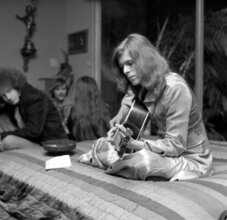
David Bowie Played a London Speakeasy for His 23rd Birthday
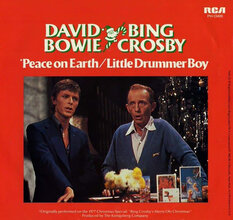
Today in 1977 David Bowie & Bing Crosby Sang Christmas Songs
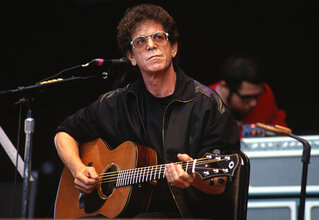
On This Day in 1997: Friends of Lou Reed Make Perfect Day '97
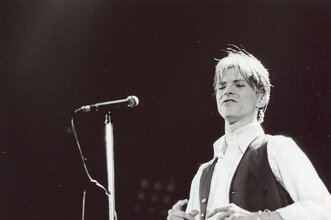
Setlist History: In 1971 David Bowie Debuted 'Changes' at 5am
David bowie gig timeline.
- Mar 04 2004 Singapore Indoor Stadium Singapore, Singapore Add time Add time
- Mar 08 2004 Nippon Budokan Tokyo, Japan Add time Add time
- Mar 09 2004 Nippon Budokan This Setlist Tokyo, Japan Add time Add time
- Mar 11 2004 Osaka-jou Hall Osaka, Japan Add time Add time
- Mar 14 2004 Hong Kong Convention and Exhibition Centre Wan Chai, Hong Kong SAR China Add time Add time
10 people were there
- paper_tiger
- toshiaizawa
Share or embed this setlist
Use this setlist for your event review and get all updates automatically!
<div style="text-align: center;" class="setlistImage"><a href="https://www.setlist.fm/setlist/david-bowie/2004/nippon-budokan-tokyo-japan-13d2d169.html" title="David Bowie Setlist Nippon Budokan, Tokyo, Japan 2004, A Reality" target="_blank"><img src="https://www.setlist.fm/widgets/setlist-image-v1?id=13d2d169" alt="David Bowie Setlist Nippon Budokan, Tokyo, Japan 2004, A Reality" style="border: 0;" /></a> <div><a href="https://www.setlist.fm/edit?setlist=13d2d169&step=song">Edit this setlist</a> | <a href="https://www.setlist.fm/setlists/david-bowie-6bd6ee66.html">More David Bowie setlists</a></div></div>
Last.fm Event Review
[url=https://www.setlist.fm/setlist/david-bowie/2004/nippon-budokan-tokyo-japan-13d2d169.html][img]https://www.setlist.fm/widgets/setlist-image-v1?id=13d2d169[/img][/url] [url=https://www.setlist.fm/edit?setlist=13d2d169&step=song]Edit this setlist[/url] | [url=https://www.setlist.fm/setlists/david-bowie-6bd6ee66.html]More David Bowie setlists[/url]
Tour Update
Marquee memories: the dandy warhols.
- The Dandy Warhols
- Apr 16, 2024
- Apr 15, 2024
- Apr 14, 2024
- Apr 13, 2024
- Apr 12, 2024
- Apr 11, 2024
- FAQ | Help | About
- Terms of Service
- Ad Choices | Privacy Policy
- Feature requests
- Songtexte.com
- Pen Online JP
- Terms & Conditions
© CCC Media House Co., Ltd.
Designed by RaNa extractive, inc.
David Bowie’s Fascination with Japan
The musician drew inspiration from kabuki theatre and traditional japanese music to assert an original sonic identity..
Words Sébastien Raineri
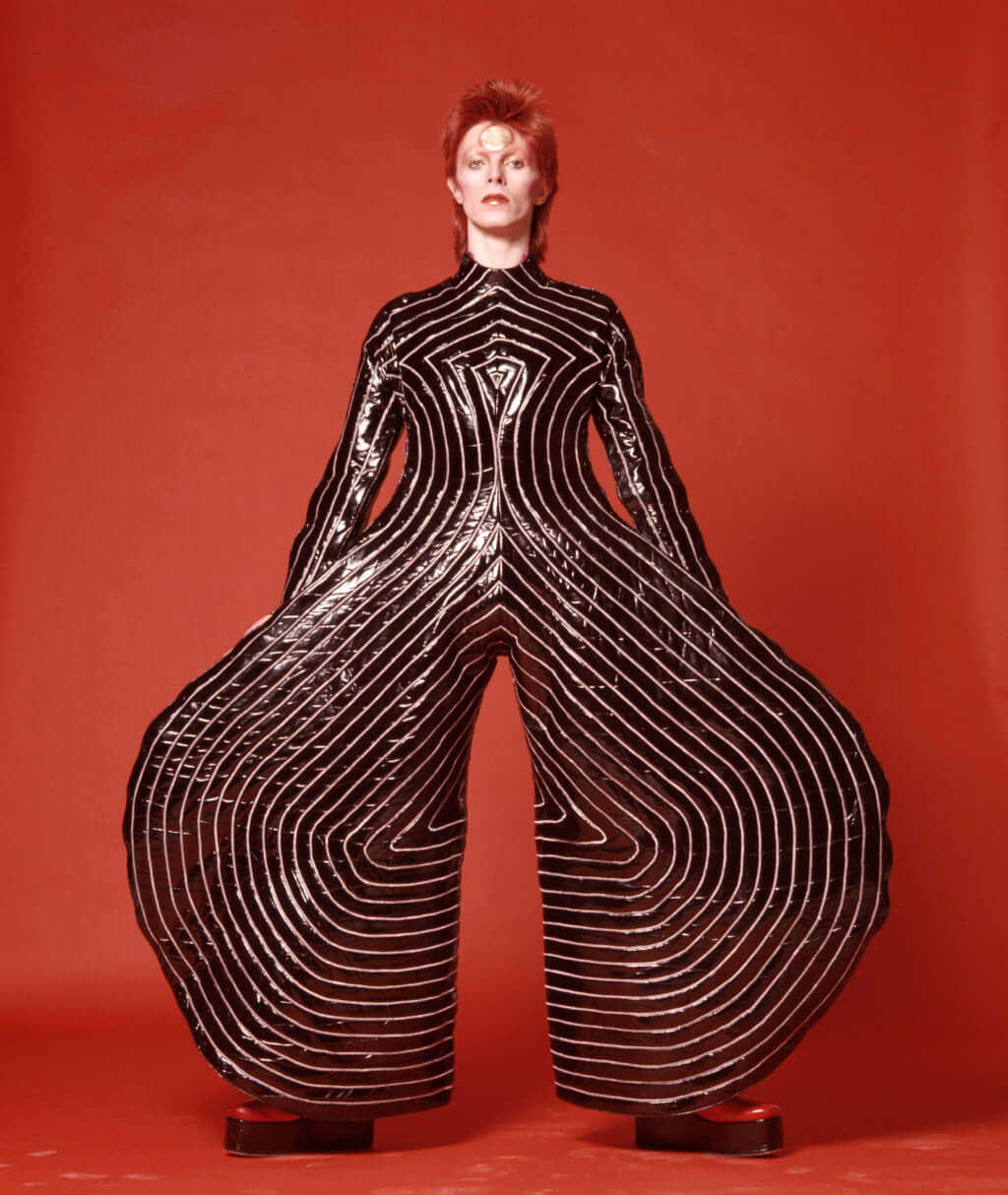
‘KABUKI’ stage costume by Kansai Yamamoto for David Bowie, 1973. Photograph by Masayoshi Sukita.
In the early 1970s, Japanese culture gained new exposure in Great Britain through exhibitions dedicated to prints ( The Floating World , 1973) and Onisaburo ( The Art of Onisaburo , 1974) at the Victoria & Albert Museum. David Bowie soaked it up and immersed himself fully in the Japanese aesthetic. He incorporated elements of kabuki theatre into his performances on stage and drew inspiration from traditional Japanese music to assert an increasingly original musical identity.
Japanese inspirations and collaborations
During this same period, David Bowie sought to develop his love for Japan, which to him represented the perfect metaphor for the notion of foreignness: ‘I think it’s the only place where I could live, apart from England’, he declared to the magazine Melody Maker . He was passionate about the films of Akira Kurosawa and Nagisa Oshima and, being an avid reader, was also a great admirer of Yukio Mishima . A polarising figure who represented a stark contrast to traditional Japanese values, Yukio Mishima was an attractive, multi-faceted man who embodied a rebellious personality refusing to conform to cultural norms, which appealed to David Bowie. In 2013, he referred to the writer in his song ‘Heat’ on the album The Next Day , in which he evokes the sinister image of a dead dog found in the novel Spring Snow . Furthermore, specific themes from Yukio Mishima’s work can be found in the film Furyo (1983) by Nagisa Oshima, in which David Bowie played a British prisoner during the Second World War, alongside Ryuichi Sakamoto and Takeshi Kitano .
Several Japanese artists played a role in the musician’s career, and contributed to his international fame. First was Kansai Yamamoto , famous for the daring nature of his avant-garde, extravagant creations that were perfectly suited to the image of Ziggy Stardust, the singer’s alter ego. This fruitful encounter allowed him to get to know Masayoshi Sukita, a young photographer. The latter travelled to London in 1972 to take photographs of Marc Bolan from the group T-Rex. He discovered David Bowie in concert and instantly decided that he wanted to photograph him. The timing was perfect, because one of the two was interested in Western culture and the other in the East. This mutual influence resulted in thousands of photographs being taken over the course of several decades, the most famous of which, and also the favourite of Masayoshi Sukita himself, is none other than the iconic cover shot for the album Heroes (1977). In 2015, David Bowie described Masayoshi Sukita as ‘a very serious artist, a brilliant artist. I would define him a master’.
Kyoto as a muse
In his songs, David Bowie used Japan as a constant source of inspiration. Oriental sounds can be heard from 1974 on the album Diamond Dogs , then Japan makes its way into the sound and lyrics starting on the album Heroes , with the singer declaring in ‘Blackout’ that ‘I’m under Japanese influence’. He was heavily inspired by the city of Kyoto, a place he loved and knew well, and which acted as a reference for the song ‘Moss Garden’ on the same album. David Bowie drew inspiration from the temple of moss when composing the music, and played the koto (a stringed instrument used in traditional Japanese music) on the recording.
He alluded to Kyoto again in the song ‘Move On’ on his album Lodger (1979), then referred to Japan in ‘Ashes to Ashes’ from Scary Monsters (And Super Creeps) . For this opus released in 1980, he recorded an instrumental initially entitled ‘Fujimoto San’, which was intended to close the album. The track was released as a single in Japan in July 1980 under the title ‘Crystal Japan’, and served as the music for a Japanese television advert shot in Kyoto for the alcoholic drink Shochu Crystal Jun Rock.
David Bowie’s love for Japan can be felt not only in his music, but also in his image and popularity, and reflects a mutual fascination between two cultures so different to each other that they could not help but come together.
Heroes (1977), an album by David Bowie released by RCA Victor.
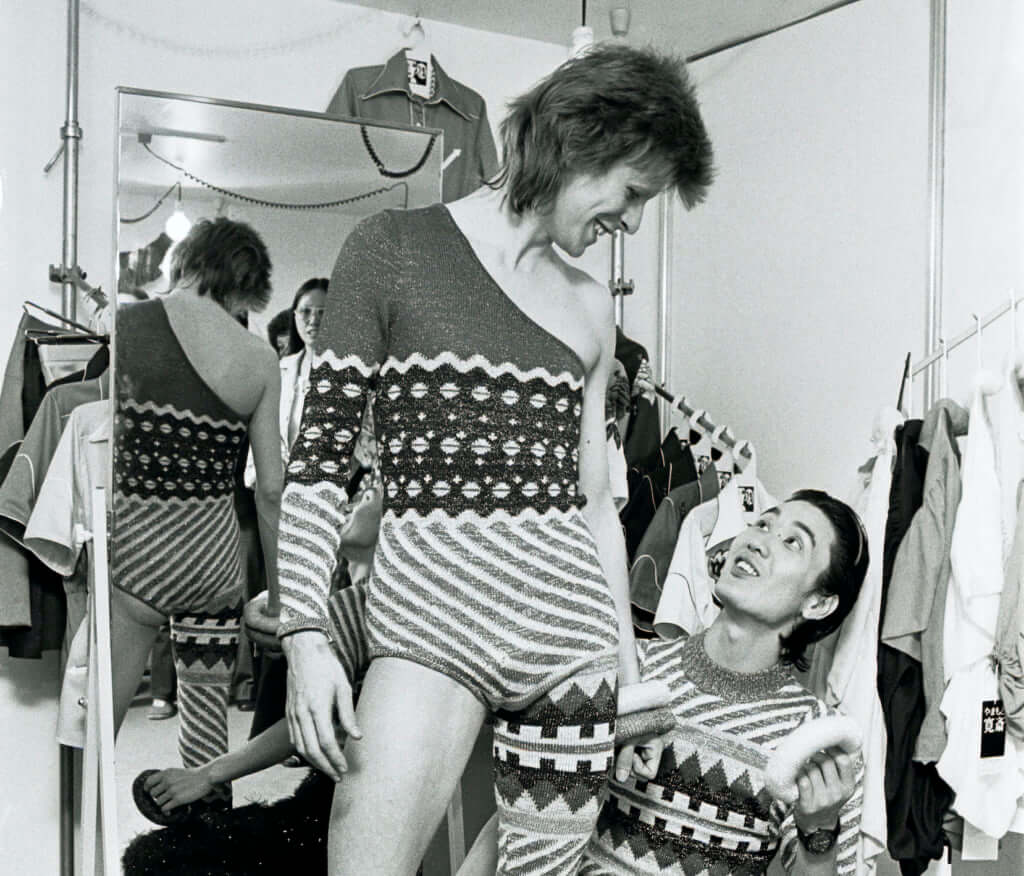
David Bowie and Kansai Yamamoto, 1973. Photograph by Masayoshi Sukita.
- Masayoshi Sukita
- David Bowie
- photography
Visible only twice a year, ‘Empty River’, designed by landscape architect Marc Peter Keane, evokes the carbon cycle.

19th-century photographs have captured the usually hidden tattoos that covered the bodies of the members of Japanese organised crime gangs.

Makeup, beard shape, organisation of cupboards and meeting places: all of these details decipher 1920s Tokyoites.

Only two hours from Tokyo, this park with thousands of flowers is worth visiting several times a year to appreciate all its different types.

Yoshitomo Nara's little girls with big eyes unsettle the viewer with the violence they exude and force them to discern the imperceptible.
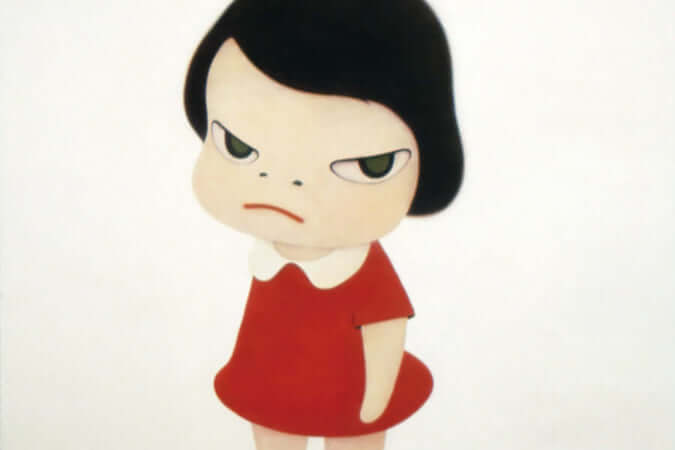
Looking for David Bowie in Kyoto
The music legend was a lover of this iconic Japanese city, and if you push beyond the usual tourist sights you can find what he did.

Laura Studarus
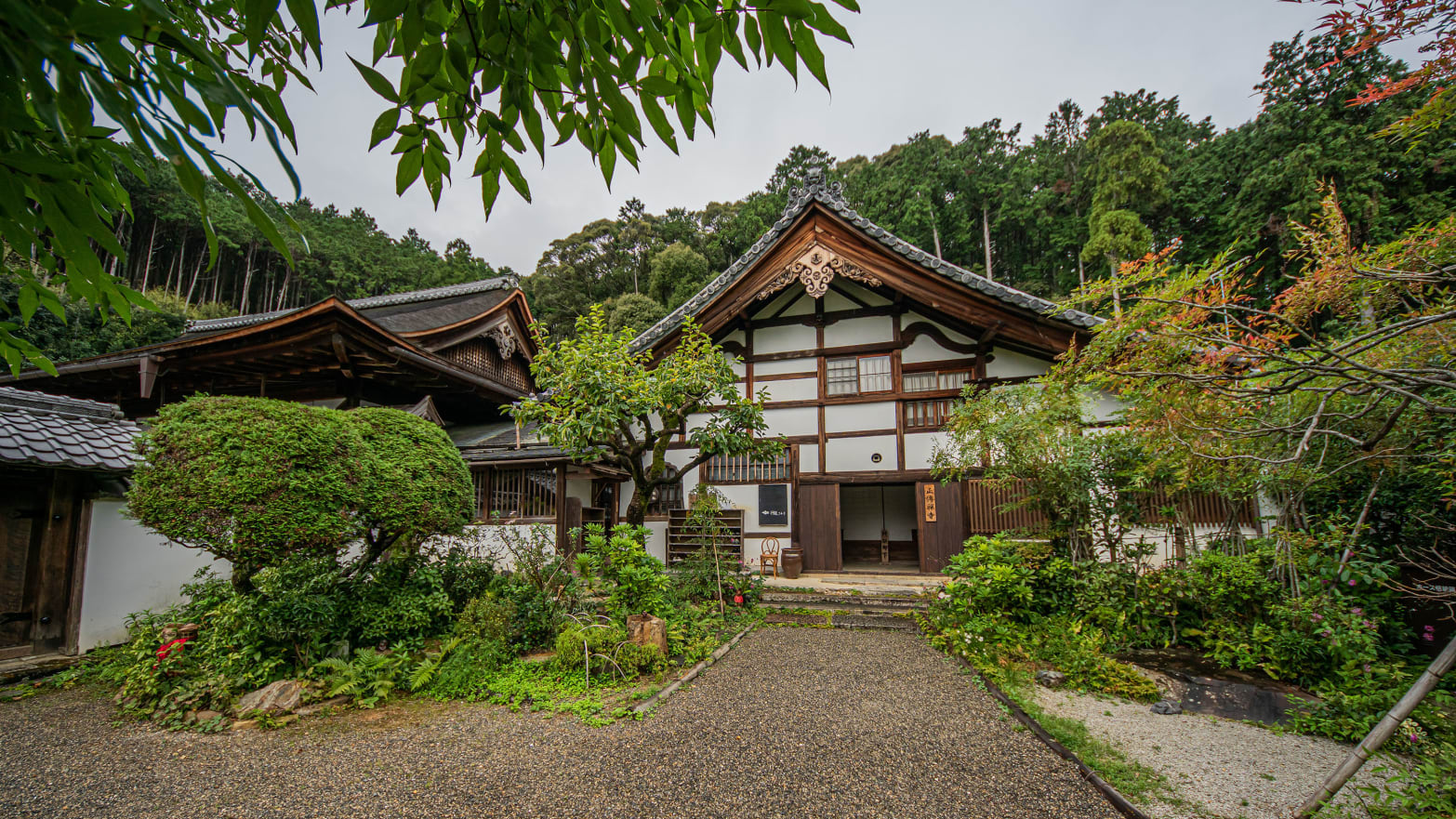

Joshua Mellin for The Daily Beast
David Bowie was fascinated by Japan. But he loved Kyoto, to the point where he considered making it his permanent home. Although, as he explained in a radio interview with Andy Peebles in 1980, there was something holding him back.
“I’m not quite sure where to go next,” he said. “The East beckons me—Japan—but I’m a bit worried that I’ll get too Zen there and my writing will dry up.”
Sharing an idealized view of the city, I understand his mindset. But by the time I’ve made my third pass through Furukawa shotengai, I’m not so much zen as confused, as are the local shop owners watching me pace. The shopping arcade, built in 1963 but boasting a tradition that dates back to the Edo period (1603–1868), is full of food vendors and restaurants, much like its tourist-filled counterpart Nishiki Market. But instead of looking for a snack or souvenir like a sane tourist, I’m on the hunt for a vegetable stand called Nodoya that Bowie stopped at nearly fifty years ago.
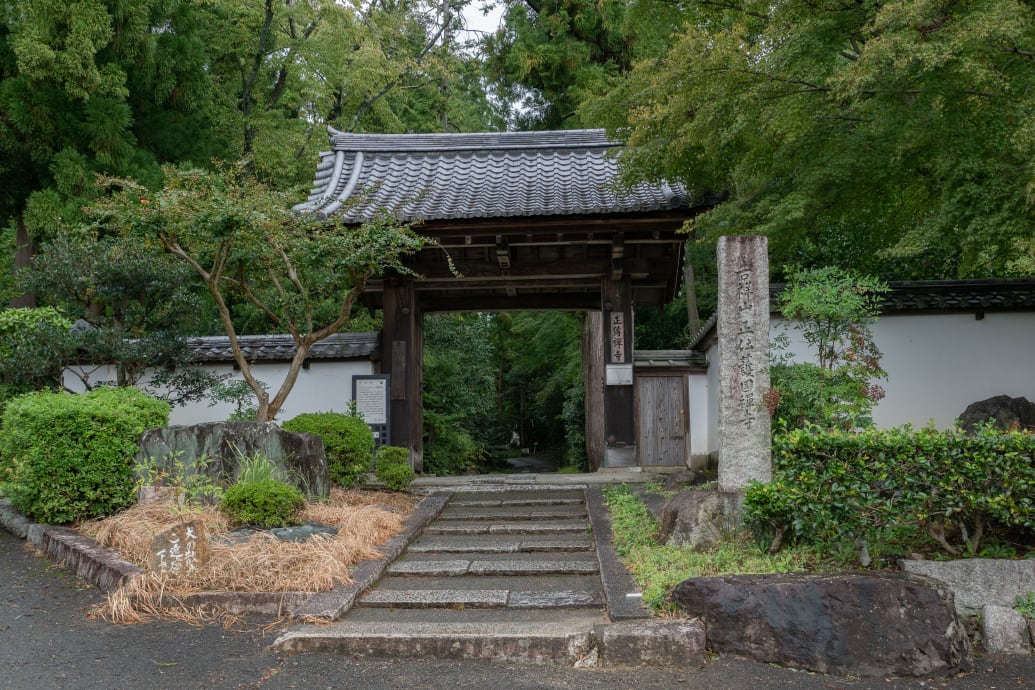
After several attempts and multiple visits, I finally give up. Thanks to several Google-translated conversations, and help from the owner of nearby El Puente Coffee Laboratory, who agreed that Bowie “was pretty cool,” I finally learn that the stand, which up until recently proudly displayed a black-and-white photo of the musician making his purchase, was in fact closed for good, as indicated by several locals crossing their arms in dramatic crosses across their body. We know Bowie’s exact order (yawata-maki, or vegetables simmered in sweet soy sauce, then wrapped and grilled in thin slices of beef) but the visceral thrill of buying the same lunch at the same shop no longer exists. I snap a photo of empty, lantern-festooned walkway, and attempt to feel thankful that this mission has taken me to a part of the city I’ve never fully explored.
Even four years after Bowie’s passing at the age of 69, it’s still tempting to find new entry points into the iconic artist’s life story, which is exactly what I’m hoping to accomplish by traipsing through parts of my favorite city in hopes of finding tiny, Bowie-approved landmarks. Kyoto is an extremely comfortable place to visit. Walking along the broad boulevards near the Kamo River, or hiking through the surrounding mountain range, there’s physical space that’s unavailable in Osaka or Tokyo, the other two points in Japan’s golden-triangle of tourism. But I seem intent on using only a small corner of it. Why not break out of the routine acquired through my regular visits, and try to see the city in a different light?
However, because they are not marked up in a commercial capacity, like say, a “Beatles in Hamburg” tour, playing connect the dots to create the picture of Bowie’s Kyoto requires some detective work. This is unfortunately even more true after the passing of his friends and city guides David Kidd and Yasuyoshi Morimoto. Yet, stories of their exploits still sound enticing.
“We met Bowie through his Japanese makeup artist,” Morimoto told Arts and Antiques magazine in 2015. “He liked to come to Japan to present concerts, and we became good friends with him and his wife, the fashion model Iman … We used to drive Bowie, disguised, around Kyoto—in the Cadillac.”
Although the majority of his visits to Kyoto were for pleasure, rather than work, Bowie’s admiration of the city was a prime feature in many of his collaborations. Designer Kansai Yamamoto created costumes for both The Rise and Fall of Ziggy Stardust and the Spiders from Mars and Aladdin Sane , transforming his 1972 tour into a celebration of kabuki in space. It was an idea extrapolated directly from Kyoto’s Gion District, which is populated by Geiko (“person of the arts”).
Walking through the neighborhood’s narrow streets in search of similar inspiration can be hit-or-miss. During daylight hours, it’s a sea of closed restaurants, save for the neon-colored cocktail slinging Planet Hollywood. Taking an Instagram here would be a disappointing exercise in photographing non-descript wood buildings, although I do spot a geisha painted onto one of the city’s omnipresent vending machines. But that changes around dusk when the red lanterns are lit, and the iconic entertainers, dragged into pop culture through Memoirs of a Geisha (denounced as inaccurate), and tourists turned paparazzi (denounced as straight-up rude), emerge to lead clients to private clubs. Watching the women working in striking white makeup, it’s easy to see the connection between their artistry and Bowie’s trussed-up, new wave alter-egos Ziggy Stardust and Aladdin Sane.
While the Geiko fed Bowie’s desire to become something greater than himself, the area surrounding Gion across downtown Kyoto helped establish his humanity. As photographer Masayoshi Sukita told me via email, Bowie “wasn't interested in touristic places, but places [where] ordinary people live.” Thanks to his collaborations with Sukita (who also snapped the image of his 1977 album Heroes ), we have glamorous images of him appreciating those banal slices of daily life, fighting with an umbrella, lighting a cigarette in a tea house, and—most notably—casually taking one of the subways.
The Hankyu Kyoto Line, where he was photographed, still runs with startling regularity between Kawaramachi Station in Kyoto and Umeda Station in neighboring Osaka. Even now, it is outfitted with similar same low-hanging hand loops. While seemingly non-descript, the appeal to the near-silent cars is evident. Although Bowie may have physically stood out on public transit, no one seemed to care, a privilege he rarely enjoyed as his popularity grew.
“He wasn't very famous at the time [we were] in Kyoto,” Sukita recalls. “Only a few students noticed, but there were no messes. I think he enjoyed the situations.”
Even though transit across Kyoto is smooth enough to stand without holding on, I sit to enjoy the same immaculately clean green seats and yellow walls captured in Sukita’s images. No one talks to me either.
But the most satisfying stops on a David Bowie-inspired tour of the city benefit from Japan’s enduring sense of traditionalism, something that Sukita confirms was a major draw for the musician. Visitors from around the world come for the sense of history, preserved in temples like Kinkaku-ji and Kiyomizu-dera. Bowie was one of those seekers, delving so far into the subject that he did some training to become a Buddhist monk. Because of that interest, when he first saw Shoden-ji Temple in 1979, he reportedly burst into tears. It was an emotional connection that led him to mix spirituality with commerce when he filmed the surreal commercial for Takara Sake on the site in 1980. (“No one has ever asked me to do it before,” he said in an interview during the time. “And the money is a very useful thing.”)
Located two buses north of the city center in the Kita-ku ward, reaching the azalea bush-lined driveway of the Zen Buddhist temple requires a stroll through a feline-patrolled residential area, and a hike up a hill covered in a dense bamboo forest, empty, unlike the more tourist-infested growth at Arashiyama. This trek alone keeps most Instagram-hunters away, its non-touristic status evident by an unpainted timber torii gate at the entrance, and general unpolished, homely feeling. I pay the 400-yen entry fee, slip off my shoes, and sit quietly, staring out at the immaculately raked garden alongside several people clearly more interested in using the temple for its intended purposes. While it’s subjective what enlightenment is supposed to feel like, even the roof, which supposedly contains bloodstained floorboards from the dismantled Fushimi Castle, only adds to the building’s peaceful atmosphere. I can’t tell if it's the Japanese aesthetic at work, or if I’m just thankful not to be among the horde of tourists climbing through the endless orange gates at the Fushimi Inari Shrine, but I do feel calm. Omamori, wooden temple charms, featuring a gesture drawing of a cat, are available at the entrance for 1000 yen. I offer the monk my money and a deep bow, hoping to hide the fact I’m buying the charm strictly for the Ziggy Stardust reference.
Getting into Saiho-ji Temple , the second of Bowie’s inspiring temples, proves to be another long haul. The Zen Buddhist temple, also called “Kokedera” (Moss Temple) is located in the Nishikyō Ward, just out of reach of less ambitious visitors. It’s also a stretch for the less organized. To prevent it from becoming overrun, in 1977 the UNESCO World Heritage site began requiring would-be visitors to register three months ahead via postcard.
The Heroes album track, “Moss Garden,” was inspired by its immaculately manicured gardens, is walled off to all but the truly devoted. However, the area around the temple, deep into Arashiyama mountains, remains the opposite of traditional Japanese gardening, the thick beds of moss giving way to tangled, Goblin King-evoking vegetation, trees torn up by the typhoon that hit 48 hours before our visit, and a creek where a group of splashing kids ask us to take their photos. It’s not the Brian Eno-assisted tranquillity of “Moss Garden,” but it is peaceful. That is until I scream at the sight of a crudely constructed scarecrow, because I am an anxiety-prone human and not a zen-seeking rock star.
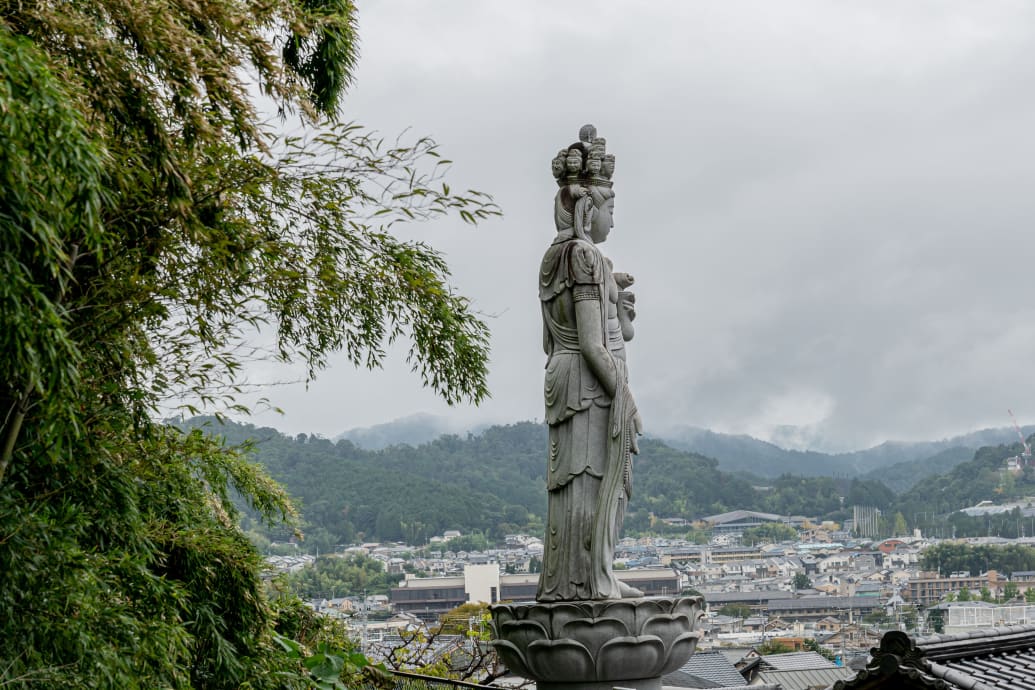
It would be a mistake to paint Kyoto as a city exclusively comprised of temples, even though there’s more than 1,600 of them. It’s still a modern city, its Family Mart convenience stores and Starbucks more prominent than places of worship. You will see women dressed in traditional kimonos with elaborate obi sashes, but you’re never far away from a Uniqlo. It’s a stop on the Shinkansen, which, when it opened in October 1964 set the standard for high-speed travel, though one of their oldest tea companies has a stand in the train station.
This ever-shifting combination of modernity and tradition makes locations that have endured simply by soldiering on even more impressive. Bowie’s reported favorite udon house, Misoka-an Kawamichiya , located in downtown Kyoto, is 310 years old—making it 67 years older than the United States. Their booths are small, with floor sitting areas that require both the removal of shoes and a cross-legged sitting position. At 5’10,” Bowie probably pulled off the pose fairly well. The Yamakake, homemade buckwheat soba and with grated yam and a quail egg, is delicious, and given at this point I’ve logged over 20 miles of walking, quickly eaten.
The restaurant is just down the street from Tawaraya Ryokan, where Bowie and Iman stayed during their 1992 honeymoon. Now 300 years old and in its 12th generation of family ownership, the traditional Japanese hotel was once called one the eight most exclusive hotels in the world by Forbes magazine and if the reports are to be believed, not much has changed since that 1974 declaration.
The establishment bridges the gap between old and new Kyoto. Its eighteen rooms feature private garden views, and large, Japanese-style wooden baths. In accordance with traditional Japanese inns guests are well taken care of, with a server that delivers in-room meals, draws baths of naturally heated spring water, and lays out a lavish bed roll each night. They also advertise internet, and in-room refrigerators. I say advertise, because despite the jaw dropping rate of $600-$800 dollars per person which, in a moment of delirium I briefly considered, there was no available rooms.
Instead of staying the night as planned, I stop by for a look, only to discover after slipping off my shoes at the entrance, that most ryokans don’t have a lobby as everything is done in the privacy of a guest’s room. And, good news for any would-be celebrity visitors, the woman behind the desk was also clearly more interested in the privacy of those staying there—past and present—than expounding on what Bowie and Iman may or may not have experienced.
“We have many guests who stay here,” the concierge said cryptically, when I bring up the topic, effectively shutting down my request. Instead, she hands me an embossed pamphlet, which ironically does name drop a few of their A-list patrons. (Shout out to Barbra Streisand, Dustin Hoffman, and Nicholas Cage for their good taste.) With that, she gently guides me back toward my shoes and the door. As my photographer and I walk down the street, I periodically turn to look back to find the woman joined by another hotel worker, vigorously bowing.
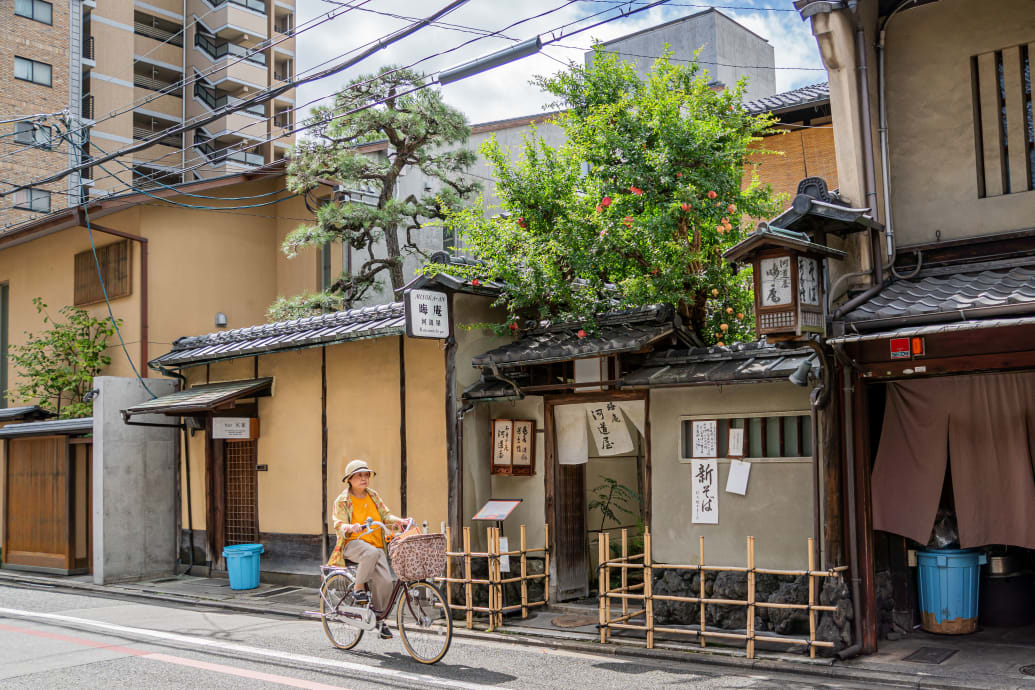
Joshua Mellin for the Daily Beast
Moral of the story: if you’re going to get bounced, do it in Japan.
I walk back to my much cheaper, non-rock star approved hotel. It’s a fantastic piece of foolishness to believe you can dip into the same city someone experienced over 40 years ago. But if there’s one constant to his life and career, it was a sense of comfort in the mist of change, a message he managed to hold on to even while writing his own farewell album. My version of Kyoto, from the monkeys of Iwatayama, to the budding sakura blossoms, to the feeling of matcha ice cream melting all over my hands in the midday sun, will never fully echo Bowie’s—even when I’m attempting to manufacture an experience that follows in his footsteps. But something tells me he would have appreciated it all the same.
Got a tip? Send it to The Daily Beast here .
READ THIS LIST
Inside Kyoto
A Kyoto Travel Guide
David Bowie’s Kyoto
With the arrival of the David Bowie Is exhibition in Tokyo, Chris Mitchell discovers David Bowie’s favorite places in Kyoto

When David Bowie passed away on January 10 2016, amongst the deluge of tributes were several well-written pieces about Bowie’s fascination with Japan. To celebrate the opening of the David Bowie Is exhibition in Tokyo on January 8 2017, (what would have been Bowie’s 70th birthday), here’s a collection of the best stories and anecdotes about Bowie’s time in Kyoto.
Long before he ever visited the country, Japan had a hold on David Bowie’s imagination. The pre-famous Bowie had studied with mime artist Lindsay Kemp in the 1960s, whose style was heavily influenced by kabuki . Bowie in turn drew on Kemp’s teachings in the construction of his Ziggy Stardust persona. The iconic Ziggy lightning bolt across the face reflects the boldness of kabuki makeup, as did his appearance in the Life On Mars video .
Touring allowed Bowie to visit Japan frequently. Some of the iconic Ziggy Stardust costumes from the early 70s were designed by Kansai Yamamoto and, indeed, Bowie’s most famous alter ego is referenced in his own theme song as "some cat from Japan". You can see many of those stage costumes in the David Bowie Is exhibition. You can also read more about Yamamoto and the kabuki connection in this BBC article .
Kyoto was Bowie’s favorite city in Japan, to which he returned several times. As Scottish musician and fellow Japanophile Nick Currie, aka Momus, points out, he almost made Kyoto his home .
There is a well-known collection of black and white photos of Bowie in the late 70s wandering around Kyoto, taken by his trusted collaborator Masayoshi Sukita. (Sukita also shot the iconic "Heroes" album cover amongst many other Bowie images. His Speed of Life book recaps their 40 years of working together. See also this great overview of Sukita’s career ). According to RocketNews24’s Meg Murphy , one of these photos was taken at a small food stall called Nodoya which still proudly displays the photo of Bowie making a purchase from the owner!

The track Moss Garden on the "Heroes" album was inspired by Saiho-ji temple or Koke-dera , the moss temple. (See Chris O’Leary’s comprehensive rundown on the genesis of the track ). There’s also another Kyoto temple that reportedly moved Bowie to tears in the rather bizarre context of filming an advert in December 1979. Many famous Western actors and musicians make lucrative adverts in Japan (a process immortalised by Sofia Coppola in Lost In Translation ). Bowie had agreed to shoot an advert for Crystal Jun Rock shochu. The advert features a Bowie original composition, Crystal Japan , and was shot at Shoden-ji Temple , a relatively obscure Zen temple in northern Kyoto. In the advert itself, Bowie is surrounded by darkness and the Zen garden is visible for about 2 seconds at the most, with just the cones of sand denoting its presence viewed over Bowie’s shoulder.
There’s another just-published piece about Bowie and Shoden-ji in the Asahi Shinbun newspaper . If you’re interested in understanding more about Kyoto and Zen in general see Kyoto’s Best Zen Gardens .
The track Crystal Japan was originally intended for inclusion on the 1980 album Scary Monsters (and Super Creeps) but never made the final cut, thus becoming a single originally only released in Japan. (The album opener, It’s No Game (No 1), features a strident spoken Japanese language vocal by Michi Hirota).
Inside Kyoto’s Chris Rowthorn recalled another booze-related Bowie anecdote in his essay for Deep Kyoto:Walks
"I wanted to see another side of the night – something that wasn’t a bad memory. So, I followed Kiyamachi south, back across Sanjo. I walked south until just before the former Rissei Elementary School, where I turned right down an alley. I walked down until I reached Tosa Inari Shrine, where I turned left into an even smaller alley. I was looking for a bar I used to go to called Zappa. …Zappa was a funky little joint with a vaguely Indonesian theme that was run by a lovely Japanese lady named Hiroko. It was a good place to drink, but the main reason anyone went there is because they had heard that David Bowie once dropped in by surprise. I thought the whole story was bullshit until Hiroko pointed out a picture of Bowie chilling out against the wall, with a few Japanese on either side looking very pleasantly bemused. When you went to Zappa, you went with the expectation that Bowie might just drop by again. The patrons waited for Bowie to reappear like eager Hasidim waiting for Elijah at a particularly happening seder. With the sound of footsteps in the alley, heads would turn toward the door and you would feel the air tighten. Is it Bowie? Bowie-san ka naa? But it never was Bowie, just another random character, perhaps another gaijin who had come to join the Bowie vigil, or perhaps a young Japanese dude squiring his woman to a place where they could drink with scary creatures like gaijin."
Bowie was fascinated by art of all kinds, and Japanese art was no exception. Antique dealer Yasuyoshi Morimoto explains in an interview with Arts And Antiques magazine how he and his partner David Kidd helped Bowie explore Kyoto incognito after he became mega famous in the 1980s.
In the world of Asian art collecting, Kidd and Morimoto became the go-to experts for a range of inquisitive, discreet clients, like the rock star David Bowie. “We met Bowie through his Japanese makeup artist,” Morimoto recalls. “He liked to come to Japan to present concerts, and we became good friends with him and his wife, the fashion model Iman.” Photos in the collector’s home show Kidd, Morimoto, Bowie and his companions dining together in tatami-matted rooms. “We used to drive Bowie, disguised, around Kyoto — in the Cadillac,” Morimoto recalls with a chuckle.
Bowie and Iman spent their honeymoon at Tawaraya ryokan , the most exquisite traditional Japanese inn in the country. Iman recalled in a 2012 interview with FurtherMore "My honeymoon was my best vacation ever! We got married in Florence, Italy and then went to Bali for two and a half weeks, then to Kyoto, Japan for one week. Just a divinely sexy trip."
The David Bowie Is exhibition will open in Tokyo on January 8 and run to April 9 2017. It’s located at Warehouse TERRADA G1 Building in Tokyo’s Shinagawa district.
You can buy tickets online at the official David Bowie Is Japanese site (English language).
See also the official press release on DavidBowie.com
If you’re planning to visit Tokyo to see the exhibition, see Inside Kyoto’s companion website TrulyTokyo.com for a comprehensive travel guide.
Thanks to Michael Lambe of Deep Kyoto for his help and suggestions for inclusions in this article.
Kyoto Vacation Checklist
- For all the essentials in a brief overview, see my First Time In Kyoto guide
- Check Kyoto accommodation availability on Booking.com and Agoda.com - often you can book with no upfront payment and free cancellation
- You can buy shinkansen (bullet train) tickets online from Klook - popular routes include Tokyo to Kyoto , Kyoto to Osaka and Kyoto to Tokyo
- Need tips on where to stay? See my one page guide Where To Stay In Kyoto
- See my comprehensive Packing List For Japan
- Buy a data-only SIM card online for collection when you arrive at Kansai International Airport (for Osaka and Kyoto) or Tokyo's Narita Airport . Or rent an unlimited data pocket wifi router
- Compare Japan flight prices and timings to find the best deals
- If you're making frequent train journeys during your visit, you might save money with Japan Rail Pass – see if it's worth it for you
- A prepaid Welcome Suica card makes travelling around Kyoto easy – here's how
- World Nomads offers simple and flexible travel insurance. Buy at home or while traveling and claim online from anywhere in the world
Kyoto District Map

- Central Kyoto
- Northwest Kyoto
- Northern Higashiyama
- Southern Higashiyama
- Downtown Kyoto
- Kyoto Station Area
- South East Kyoto
Disclosure: InsideKyoto.com is a participant in the Amazon Services LLC Associates Program, an affiliate advertising program designed to provide a means for sites to earn advertising fees by advertising and linking to amazon.com and amazon.co.uk. World Nomads provides travel insurance for travellers in over 100 countries. As an affiliate, we receive a fee when you get a quote from World Nomads using this link. We do not represent World Nomads. This is information only and not a recommendation to buy travel insurance.

- Kyoto Books
- Kyoto Poetry
- Featured Writings
- Featured Writers
- Book Reviews
- Writing Competition
- Become a Member
Membership Fee
- Kyoto Lit. List
Share this:
- Click to share on Facebook (Opens in new window)
- Click to share on Twitter (Opens in new window)
- Click to print (Opens in new window)
- Click to email a link to a friend (Opens in new window)
On Kyoto , WiK members
Bowie Bowie and Kidd Bowie and Moss Garden Bowie in Kyoto Bowie pics David Bowie David Kidd Yuki Yamauchi
- Kyoto Journal Releases Issue 105: The Geography of Myth
- April 14: Simon Rowe
- May 19- Allen Weiss
- June 16: Words and Music
WiK Writing Competition

Eighth Annual Writing Competition Winners (2023)
Previous years: Seventh Annual Writing Competition Winners (2022)
Sixth Annual Writing Competition Winners (2021)
Fifth Annual Writing Competition Winners (2020)
Recent Posts
- The Dogs’ Logs
- Lisa Wilcut on Translation
- Book Review: A Tiny Nature
- WiK website TOC
Don’t Miss
- Kyoto: A Literary Guide
- A listing of writings about Kyoto
Email Address
WiK Anthologies

The Nature of Kyoto (2023) Eds. Lisa Twaronite Sone & Robert Weis Foreword by Pico Iyer

Structures of Kyoto (2021) Eds: Rebecca Otowa & Karen Lee Tawarayama Foreword by Judith Clancy

Encounters with Kyoto (2019) Eds: Jann Williams & Ian Josh Yates Foreword by Juliet Winters Carpenter

Echoes (2017) Eds: John Dougill, Amy Chavez, & Mark Richardson Preface by Alex Kerr
Pay your annual membership fee
Member Authors
- John Dougill (Founder) Non-fiction about Japan
- David Duff Self-published author
- Ted Taylor Writer, blogger, internationalizationer
- Karen Lee Tawarayama (Competition Organiser) Blogger, Translator/Interpreter
- Robert Yellin Columnist, author and expert on ceramics
- Ken Rodgers Kyoto Journal managing editor
- James Woodham Translator, poet and photographer
- John Einarsen Founding editor, Kyoto Journal, photographer and publisher
- Eric Bray Academic writer
- Preston Keido Houser Author, poet and shakuhachi blogger
- Marianne Kimura Academic writer and novelist
- Allen S. Weiss Writer, photographer, teacher, gourmand
- David Joiner Literary novelist
- Paul Carty (Treasurer) Academic author
- Mayumi Kawaharada (Japanese Liaison) Poet and vegetarian blogger
- Jann Williams (Anthology Supervisor) Writer, blogger, ecologist
- Hamish Downie Writer and producer
- Ian Richards Short story writer and biographer
- Cody Poulton Theatre critic, translator, essayist
- Mark Hovane Writer on Japanese gardens
- Gary Tegler Narrator and jazz musician
- Simon Rowe Author and screenplay writer
- Alex Kerr (Honorary Member) Japanologist, art connoisseur and rural revivalist
- Christopher Herron Wordsmith
- Kirsty Kawano Freelance journalist and translator
- Fernando Torres (Instagram) Fantasy and Historical Fiction
- Mike Freiling Poet, translator and short story writer
- Judith Clancy Books about Kyoto and J. culture
- Nicholas Teele Academic writer and translator
- Rebecca Otowa (Reviews) Various genres incl. Japan non-fiction and illustration
- Mark Willis Academic writer, personal essayist
- Reggie Pawle Pyschotherapy, intercultural studies and blogger
- Malcolm Ledger Essayist and occasional poet
- Michael Greco Self-published fiction
- Lisa Wilcut (Zoom Manager) Non-fiction, short fiction, poetry
- Julian Holmes Translator
- Catherine Pawasarat Spiritual adventure non-fiction
- Rona Conti Calligraphy expert and writer
- Everett Kennedy Brown Writer and Venture Capitalist
- Robert Weis Travel and geopoetry
- Felicity Tillack Filmmaker, blogger and poet
- Tina deBellegarde (Membership Secretary) Novelist, short fiction writer, book reviewer
- Stephen Mansfield Non-fiction writer, photographer
- Lisa Twaronite Sone Journalism, fiction, copyediting
- Edward Levinson Photographer, essayist, poet
- Yuki Yamauchi Translator and writer
- Andrew Innes Short story writer
- Liane Wakabayashi Memoir writer, journalist, artist
- Stephen Benfey Short story writer
- Suzanne Kamata Author and Editor
- Nathan Mader Poems and Drawings
- Rick Elizaga Web Designer
- Eleanor Yamaguchi Academic Writer and Historian
- Andrew Kozelka Poet, Novelist, Short Story Writer
- Sara Ackerman Aoyama J-E Translator, Librarian and Writer
- Rebecca Copeland Academic writer, translator, novelist
- Alejandra Olivera Historic Japanese Fiction, Clinical psychologist, Artist, Musician
- Amber A. Logan Speculative Fiction Novelist
- Jonah Salz Academic Writer, Translator, Editor
- Elaine Lies Journalist, Fiction
- Lea Millay Poet
- Richard Byford Writer, diarist, Japanologist, countryside explorer.
- Susana Tosca Media researcher, writer, traveller
- Amanda Huggins Author, travel writer, poet
- Yasuo Nagai cross-industry exchange host
- Daniel Kelly artist
- Alison Miyake Future Writer
- Kimika Mizushima Poet
- Tanya Korchuk Teacher, Translator, Writer
- David Rycroft Academic, Japan Studies
- Shuri Obayashi illustrator, writer, editor
- Abigail Deveney Story-listener, storyteller
- Bruce Hamana chanoyu student and teacher, essayist
- C. Greenstreet Fiction writer
- Eldad Shary author, musician, creativity workshop leader
- Diane Durston Author, cultural consultant, curator emerita
- Daniel Sofer Landscape & Architecture Photographer, Blogger, Author
- Shinya Tsugimoto Academic Writer, Buddhism Researcher
- Mayumi Yamamoto academic writer and essayist, court interpreter
- Travis Belrose Novelist
WiK on Facebook
Public Group Members Group
- Kyoto Journal
- SWET : The Society of Writers, Editors, and Translators
- Deep Kyoto Local news and views
- Amy on Asia Amy Chavez on Asian matters
- Books on Asia Guide to quality books on Japan and Asia
About Writers in Kyoto
Recent comments, questions, feedback.
© 2024 Writers In Kyoto
Based on a theme by Anders Noren — Up ↑
- Anti-Piracy Statement
- Anti Spam Policy
- Privacy Policy
GiGinJapan Artwork of Japanese CDs (mostly)
David bowie / sound + vision japan tour 1990 / 2 blu ray r.
in 1990s , David Bowie , Sound & Vision Archive Collection 2016/03/28 839 Views
David Bowie / Sound + Vision Japan Tour 1990 / 2 Blu Ray R / Sound & Vision Archive Collection
Translated Text:
Live At Tokyo Dome Ultimate Edition: Complete Version+ TV Broadcast Version. Pro-Shot / NTSC
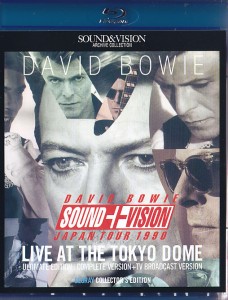
Click Image To Enlarge
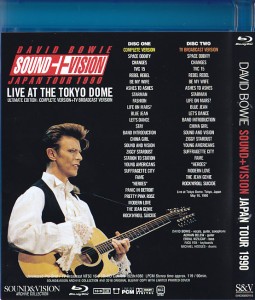
All-Time Greatest Hits Tour and became live video of when this was edited version, but has also been TV broadcast that has been cut a few songs at that time. Complete version and the TV broadcast version both the coupling before editing this time. At the time of the broadcast SD (standard), but was the picture quality Blu-ray recorded in best quality due to HD conversion. A fan must-see live video definitive edition of the “Best of David Bowie” as now and it is anew impressed thing.
オールタイム・グレイテスト・ヒット・ツアーとなったこの時のライブ映像は当時TV放送もされましたが数曲カットされた編集バージョンでした。今回は編集前のコンプリート・バージョンとTV放送バージョン両方をカップリング。当時の放送はSD(スタンダード)画質でしたがHDコンバートによるベスト・クオリティでブルーレイ収録。”ベスト・オブ・デヴィッド・ボウイ”として今となってはあらためて感動もののファン必見ライブ映像決定版です。
COMPLETE VERSION SPACE ODDITY CHANGES TVC 15 REBEL REBEL BE MY WIFE ASHES TO ASHES STARMAN FASHION LIFE ON MARS? BLUE JEAN LET’S DANCE STAY BAND INTRODUCTION CHINA GIRL SOUND AND VISION ZIGGY STARDUST STATION TO STATION YOUNG AMERICANS SUFFRAGETTE CITY FAME “HEROES” PANIC IN DETROIT PRETTY PINK ROSE MODERN LOVE THE JEAN GENIE ROCK’N’ROLL SUICIDE
DISC TWO TV BROADCAST VERSION SPACE ODDITY CHANGES TVC 15 REBEL REBEL BE MY WIFE ASHES TO ASHES STARMAN LIFE ON MARS? BLUE JEAN LET’S DANCE BAND INTRODUCTION CHINA GIRL SOUND AND VISION ZIGGY STARDUST STATION TO STATION YOUNG AMERICANS SUFFRAGETTE CITY FAME “HEROES” MODERN LOVE THE JEAN GENIE ROCK’N’ROLL SUICIDE David Bowie – vocals, guitar, saxophone Adrian Belew – guitar, backing vocals Erdal Kizilcay – bass, backing vocals Rick Fox – keyboards, backing vocals Michael Hodges ? drums Unreleased Pro-Shot / TV Broadcast NTSC 16:9 SD/HD 1920×1080 LPCM Stereo time approx. 119 / 90min.
Sound & Vision Archive Collection.SVAC006BDR1/2BDR

Related Articles
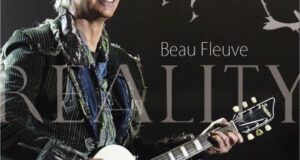
David Bowie / Beau Fleuve 2004 / 2CD
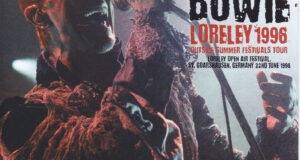
David Bowie / Loreley 1996-New / 2CD
David bowie / loreley 1996-new / 2cd +1 bonus dvdr, leave a reply cancel reply.
You must be logged in to post a comment.
This site uses Akismet to reduce spam. Learn how your comment data is processed .
After a Christmas break the continuation of the UK tour began on 5th January 1973. The Ziggy Stardust World Tours revisited the USA in February and Japan for the first time in April. During 1973, David visited four countries and produced eighty-nine performances. The band consisted of: David Bowie (vocals, 12-string acoustic guitar, Minimoog, percussion, harmonica), Mick Ronson (lead guitar, backing vocals), Trevor Bolder (bass guitar, backing vocals), Mick 'Woody' Woodmansey (drums), Mike Garson (piano, Mellotron), Brian Wilshaw (tenor saxophone, flute), Ken Fordham (tenor, baritone, alto saxophones), John Hutchinson (rhythm guitar, backing vocals) and Geoffrey Alexander MacCormack (percussion, backing vocals).
*Brian Wilshaw (tenor saxophone, flute), Ken Fordham (saxophones) and Geoffrey MacCormack (percussion, backing vocals) were added to the backing band.
Whilst David was travelling to Japan on the SS Oronsay he gave an impromptu solo acoustic performance for the ships passengers and crew.
Whilst David was travelling from Yokohama (Japan) to Nakhodka (Russia) onboard the SS Felix Dzerzhinsky, the ships crew put on a cabaret event for the passengers. He played a few songs on acoustic guitar, along with Geoff MacCormack on backing vocals and bongos.
This story is over 5 years old.
Some cat from japan - the genius behind david bowie’s best costumes.

ONE EMAIL. ONE STORY. EVERY WEEK. SIGN UP FOR THE VICE NEWSLETTER.
By signing up, you agree to the Terms of Use and Privacy Policy & to receive electronic communications from Vice Media Group, which may include marketing promotions, advertisements and sponsored content.
DCD Rights Sees Pre-Sales Boom With Remastered Bowie, Hendrix, Chicago and Elvis Titles (EXCLUSIVE)
By Callum McLennan
Callum McLennan
- Mannequin Pictures Announces Prime Video Acquisition of ‘The World’s Strangest Jobs’ With Schalk Bezuidenhout (EXCLUSIVE) 6 days ago
- ‘La Lucha,’ Set in the World of Wrestling, Rolls in the Canary Islands as Homegrown Cinema Blooms (EXCLUSIVE) 3 weeks ago
- ‘Fifty Shades of Co Pro’: A Series Mania Panel Debates the Best Way Forward for Many in Europe: Co-Production 4 weeks ago

U.K. distribution powerhouse DCD Rights is announcing strong pre-sales for its musical legend laden slate at MipTV .
Popular on Variety
The pre-sale of the “55th Anniversary Chicago Concert” to PBS and the launch of “Christmas At Graceland” are two other announcements, testament to the company’s strategic positioning within the market and a key niche among its over 3,500 hours of content.
“DCD Rights has a long history in representing music content thanks to our founder Nicky Davies Williams’ background in the music industry. We’ve worked with a variety of artists and formats as the requirements of our buyers have evolved over recent years. There is certainly a strong appetite for concerts, both classic and new, from buyers and the music documentary has seen a big resurgence in recent years,” Anderson shared.
The Graceland concert, featuring contemporary artists like Lana Del Rey and John Legend performing at Elvis Presley ‘s iconic home, looks like a seller’s dream with its mix of the classic with the contemporary.
The criteria for choosing projects for distribution lean heavily towards concerts with globally recognizable artists in significant venues, and documentaries with enticing narratives, but niche bands may have their place.
Concerts always have a long tail in terms of sales and we’ll see buyers relicensing numerous times or a number of broadcasters in the same territory licensing a concert in a way that you do not necessarily find with drama or factual.”
DCD Rights’ slew of titles underscores the unique cache a Bowie, Hendrix, or Elvis hold, and more broadly the IP potential of projects shaped around the legacies of legends in entertainment, the arts, and sport.
More From Our Brands
Prosecutors say trump violated gag order seven times since monday, this new maserati is the fastest ev convertible in the world, caitlin clark reportedly nearing eight-figure contract with nike, be tough on dirt but gentle on your body with the best soaps for sensitive skin, miss scarlet adds tom durant pritchard for first season without the duke — see photos, verify it's you, please log in.

IMAGES
VIDEO
COMMENTS
The Isolar II - The 1978 World Tour, more commonly known as The Low / Heroes World Tour or The Stage Tour, was a worldwide concert tour by the English singer-songwriter David Bowie.The tour opened on 29 March 1978 at the San Diego Sports Arena continuing through North America, Europe and Australia before reaching a conclusion at the Nippon Budokan in Japan on 12 December 1978.
@davidbowie Sound + Vision Japan Tour 1990Full ConcertLive at the Tokyo Dome. Tokyo, Japan.May 16th, 1990.Setlist:01 Space Oddity02 Changes03 TVC 1504 Rebel...
Get the David Bowie Setlist of the concert at Tokyo Dome, Tokyo, Japan on May 16, 1990 from the Sound + Vision Tour and other David Bowie Setlists for free on setlist.fm!
01 Space Oddity02 Changes03 TVC 1504 Rebel Rebel05 Be My Wife06 Ashes To Ashes07 Starman08 Fashion09 Life On Mars?10 Blue Jean11 Let's Dance12 StayBand Intro...
Tokyo Japan, Shinjuku Koseinenkin Kaikan.April 10, 1973.Quality -B+Bowie embarked on a brief tour of Japan in April of 1973 as part of the Ziggy Stardust tou...
In 1978 Bowie was at the height of his artistic expression, and below is a look at him live in action from that era. Bowie concluded the Isolar II World Tour at NHK Hall in Tokyo, Japan on ...
Get the David Bowie Setlist of the concert at NHK Hall, Tokyo, Japan on December 12, 1978 from the Isolar II Tour and other David Bowie Setlists for free on setlist.fm!
A tribute toDavid Bowie. From The Japan Times. Photos by Masayoshi Sukita and Yoshiaki Miura. David Bowie performs live at the Nippon Budokan on June 4, 1996. | Yoshiaki Miura. The late David Bowie's appreciation of Japan and its culture was strong. Following his recent death, The Japan Times asked five people who share that connection with the ...
More Moonlight in Japan. The 1983 Serious Moonlight tour reconvened 35 years ago for four dates at the Budokan Arena in Tokyo, as part of the ten day Japanese tour. Here's another Denis O'Regan shot of David in Japan from Ricochet : David Bowie 1983, ahead of our contest to win the @Bowie1983book and much more.
Get the David Bowie Setlist of the concert at Nippon Budokan, Tokyo, Japan on March 9, 2004 from the A Reality Tour and other David Bowie Setlists for free on setlist.fm!
David Bowie's love for Japan can be felt not only in his music, but also in his image and popularity, and reflects a mutual fascination between two cultures so different to each other that they could not help but come together. Heroes (1977), an album by David Bowie released by RCA Victor. David Bowie and Kansai Yamamoto, 1973.
View credits, reviews, tracks and shop for the 2016 Blu-ray-R release of "David Bowie Sound + Vision Japan Tour 1990 Live At The Tokyo Dome" on Discogs.
But the most satisfying stops on a David Bowie-inspired tour of the city benefit from Japan's enduring sense of traditionalism, something that Sukita confirms was a major draw for the musician.
How David Bowie's well-known love of Japan not only brought Japanese culture to a new audience but also may have helped heal post-war rifts. ... David Bowie, who died this week, was a well-known ...
Rare illustrated audio interview with David Bowie here, recorded in Japan in December of 1978 at the very end of his 'The Insolar II 1978 World Tour'.Want to...
David Bowie's Kyoto. With the arrival of the David Bowie Is exhibition in Tokyo, Chris Mitchell discovers David Bowie's favorite places in Kyoto. When David Bowie passed away on January 10 2016, amongst the deluge of tributes were several well-written pieces about Bowie's fascination with Japan. To celebrate the opening of the David Bowie ...
The Sound+Vision Tour was a 1990 concert tour by the English musician David Bowie that was billed as a greatest hits tour in which Bowie would retire his back catalogue of hit songs from live performance. The tour opened at the Colisée de Québec in Quebec City, Canada on 4 March 1990 before reaching its conclusion at the River Plate Stadium in Buenos Aires, Argentina on 29 September 1990 ...
The "David" in that case was U.S. Sinologist David Kidd (who also died of cancer at the age of 69, back in 1996). Kidd had a house in Kyoto called Togendo, as well as a school dedicated to teaching traditional Japanese arts. Bowie stayed at Togendo in 1979 for some weeks, and even hinted to Western press that the city might become his ...
David Bowie / Sound + Vision Japan Tour 1990 / 2 Blu Ray R / Sound & Vision Archive Collection Translated Text: Live At Tokyo Dome Ultimate Edition: Complete Version+ TV Broadcast Version. Pro-Shot / NTSC Click Image To Enlarge All-Time Greatest Hits Tour and became live video of when this was edited version, but has also been TV broadcast that has been cut a few songs at that time. Complete ...
After a Christmas break the continuation of the UK tour began on 5th January 1973. The Ziggy Stardust World Tours revisited the USA in February and Japan for the first time in April. During 1973, David visited four countries and produced eighty-nine performances. The band consisted of: David Bowie (vocals, 12-string acoustic guitar, Minimoog ...
David Bowie. David Robert Jones was born in Brixton on January 8, 1947. At age 13, inspired by the jazz of the London West End, he picked up the saxophone and called up Ronnie Ross for lessons. ... Following an Outside summer 1996 tour of Japan, the UK and Europe, an intensity of a different sort was introduced into the mix with a pair of ...
In January 1972, David Bowie and his band set out on the Ziggy Stardust Tour, an 18-month, three-continent sojourn to support the albums The Rise and Fall of Ziggy Stardust and the Spiders from ...
David Bowie Concert History. David Bowie (born David Robert Jones, in Brixton, London, on January 8, 1947) was a British singer-songwriter often regarded as one of the greatest musicians of the 20th century. He achieved his breakthrough with the 1969 song "Space Oddity," his first number-one hit single in the UK.
The remastered release of "David Bowie: Ziggy Stardust & The Spiders from Mars" in stunning 4K leads the pack with a pre-sale to NHK Japan already in place.